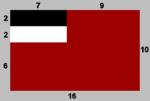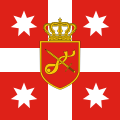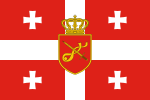Flag of Georgia
| Flag of Georgia | |
|---|---|
 |
|
| Vexillological symbol : |
|
| Aspect ratio: | 2: 3 |
| Officially accepted: | January 26, 2004 |
The flag of Georgia ( Georgian საქართველოს დროშა ), also known as the five-crossed flag ( Georgian ხუთჯვრიანი დროშა ) in Georgia, became effective with the parliamentary decision on January 26, 2004.
Appearance and meaning
The flag shows a single, right-angled cross on a silver (white) background and four smaller crosses in the corners. It is a Jerusalem cross , the crosses of which symbolize the five wounds of Christ .
The silver (white) background stands for innocence, chastity, purity and wisdom. The red of the crosses symbolizes courage, bravery, justice and love.
history
Origins of today's national flag

The central element of the flag is the red St. George's cross on a white background, as it is used today, for example, in the flag of England . There are also parallels to the standard of the Eastern Roman emperor in the late period of the Byzantine Empire under the Palaiologos dynasty . According to Georgian scholar Giorgi Gabeskiria, the additional four crosses were added to the flag under the reign of Georgian King Giorgi V the Radiant in the 14th century.
The five crosses thus became a variant of the Jerusalem cross , which the crusader Godfrey of Bouillon introduced in 1099 as the coat of arms of the Kingdom of Jerusalem . The Kingdom of Jerusalem used it until 1291. In contrast to Georgia, however, the crosses there were made in gold. Because Bouillon, as ruler of Jerusalem, called himself the protector of the Holy Sepulcher , the five crosses are also associated with the tomb of Christ.
The five-cross flag is believed to have been used in Georgia until the 15th century. Nautical charts by Angelino Dulcert (1339), Francesco and Domenico Pizigano (1367) and Sider (1565) show them on Georgian territory.
More early flags of Georgia
Flag from Samegrelo , 13th-14th centuries
Historical flags in the 20th century
From April to May 1918, Georgia was part of the Transcaucasian Federation , which had a yellow-black-red horizontal tricolor flag. On May 26, 1918, the Democratic Republic of Georgia was proclaimed. She used a dark red flag with a black and white field in the canton. The design came from the Georgian sculptor Iakob Nikoladze . The red cloth stood for the bright past. The black stripe in the Obereck stood for the dark period under Russian rule, while the white stripe stood for the hope of peaceful development.
On March 18, 1921, the republic was conquered by the Soviet Union . As part of the Soviet Union, the Georgian SSR initially had a red one with the Cyrillic letters SSRG . Between 1922 and 1936, Georgia became part of the Transcaucasian SFSR and used its flag. Georgia then became its own SSR again and from 1937 carried a red flag with the name Sakartvelos SSR in Georgian script . In the 1940s, a flag with the abbreviation SSSR followed . A new flag was introduced on April 11, 1951, which was somewhat different from the flags of the other SSRs. A red hammer and sickle with a red star in a blue sun and a blue stripe at the top of the flag. All flags during the time of the Soviet Union had one special feature: the lettering and hammer, sickle and star were missing on the back.
With independence in 1991, the flag of the Georgian Republic of 1918 was reintroduced; but with different proportions. In the late 1990s, the Georgian Orthodox Church of the Apostles urged the revival of the five-cross flag as the national flag of Georgia. A corresponding parliamentary resolution was passed in 1999, but was not implemented by President Eduard Shevardnadze . From 2003 to 2004, the five-cross flag was the party flag of the Georgian opposition party National Movement - Democrats , chaired by the later President Mikheil Saakashvili . In 2004 it finally became the national flag of Georgia.
1: 2 ? Transcaucasian Federation, April to May 1918

1: 2 ? Georgia, 1918 to 1921

1: 2 ? Georgian SSR, 1922


1: 2 ? Transcaucasian SFSR, 1922-1936


1: 2 ? Georgian SSR, 1951 to 1990


1: 2 ? Georgian SSR, back side


5: 8 ? Flag of Georgia, 1990 to 2004


Subnational flags
Abkhazia and South Ossetia have declared their independence from Georgia, which so far only a few countries have recognized. Another autonomous republic within the country is Adjara .
Abkhazia
On July 23, 1992, Abkhazia officially adopted its flag. The model for the symbol of the hand is a historical flag of Sebastopol , today's capital Sukhumi . It is listed in a book from 1350. As the ASSR, Abkhazia already had its own flag.
 ? Flag of Sebastopol around 1350
? Flag of Sebastopol around 1350
Adjara
Adjara returned to the Georgian state association in 2004. This is also made clear by the inclusion of the Georgian flag in the upper left corner of the Ajarian flag.
South Ossetia
The tricolor of South Ossetia corresponds to the flag of its Russian neighbor North Ossetia . It was adopted with the constitution of November 26th, 1990 and confirmed by the ordinance of March 30th, 1992. The tricolor with the coat of arms, known as the banner of South Ossetia , appears to be the “state flag” of the secessionist government.
Municipal flags
Georgia's municipalities also have their own flags
Government and Military Flags
2: 3 ? Naval war flag

Flag of the National Guard of Georgia
swell
- Flags of the World - Georgia (English)
Web links
- Explanation of the flag of Georgia (Eng., Georg.)
- Historical flags and coats of arms of Georgia (English)
- Historical representations of the coat of arms Gottfried von Bouillons and the Knights of the Holy Sepulcher (ital.)
- Contemporary history of the flag of Georgia

























